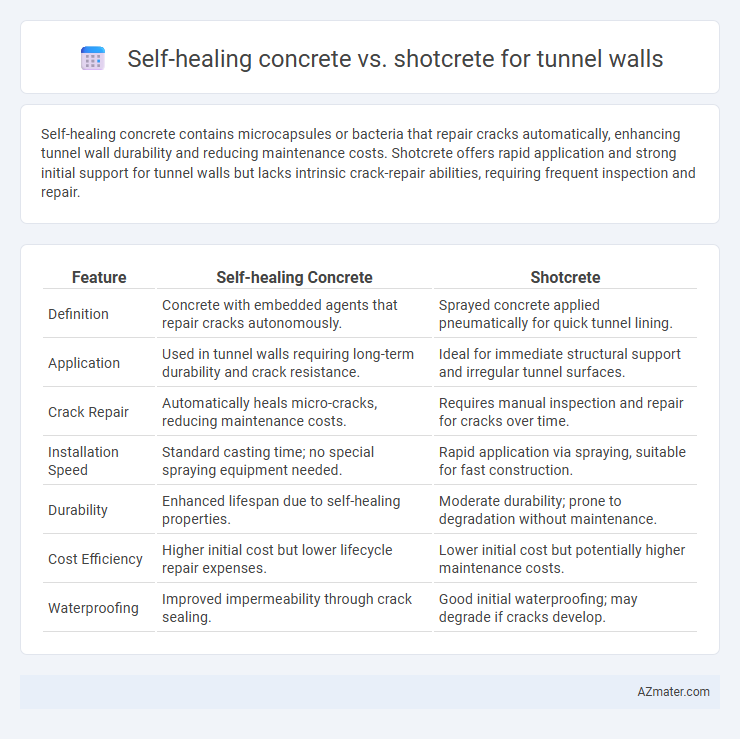Self-healing concrete contains microcapsules or bacteria that repair cracks automatically, enhancing tunnel wall durability and reducing maintenance costs. Shotcrete offers rapid application and strong initial support for tunnel walls but lacks intrinsic crack-repair abilities, requiring frequent inspection and repair.
Table of Comparison
| Feature | Self-healing Concrete | Shotcrete |
|---|---|---|
| Definition | Concrete with embedded agents that repair cracks autonomously. | Sprayed concrete applied pneumatically for quick tunnel lining. |
| Application | Used in tunnel walls requiring long-term durability and crack resistance. | Ideal for immediate structural support and irregular tunnel surfaces. |
| Crack Repair | Automatically heals micro-cracks, reducing maintenance costs. | Requires manual inspection and repair for cracks over time. |
| Installation Speed | Standard casting time; no special spraying equipment needed. | Rapid application via spraying, suitable for fast construction. |
| Durability | Enhanced lifespan due to self-healing properties. | Moderate durability; prone to degradation without maintenance. |
| Cost Efficiency | Higher initial cost but lower lifecycle repair expenses. | Lower initial cost but potentially higher maintenance costs. |
| Waterproofing | Improved impermeability through crack sealing. | Good initial waterproofing; may degrade if cracks develop. |
Introduction to Tunnel Wall Construction Materials
Self-healing concrete offers innovative durability for tunnel walls by autonomously repairing micro-cracks, enhancing long-term structural integrity and reducing maintenance costs. Shotcrete, a traditional tunnel lining material, provides immediate structural support through sprayed concrete application, excelling in rapid construction and adhesion to irregular surfaces. Comparing both, self-healing concrete addresses long-term resilience, while shotcrete emphasizes quick installation and initial strength in tunnel wall construction.
What is Self-Healing Concrete?
Self-healing concrete is an innovative material engineered to autonomously repair cracks through embedded capsules or bacteria that precipitate calcium carbonate, restoring structural integrity without external intervention. Unlike shotcrete, which is a sprayed concrete applied in layers to tunnel walls for immediate support and surface stabilization, self-healing concrete enhances durability by minimizing maintenance and extending service life. Research shows that incorporating self-healing properties in tunnel lining materials can reduce permeability and prevent long-term deterioration caused by environmental factors and mechanical stress.
Overview of Shotcrete Technology
Shotcrete technology involves spraying concrete at high velocity onto tunnel walls, enabling rapid application and strong adhesion to complex surfaces. Its immediate setting and high compressive strength make it ideal for stabilizing excavations and providing structural support in tunneling projects. Compared to self-healing concrete, shotcrete offers quicker reinforcement but lacks intrinsic crack-repairing capabilities.
Comparative Installation Process
Self-healing concrete reduces maintenance frequency in tunnel walls by autonomously repairing micro-cracks through embedded healing agents, requiring standard casting techniques but careful curing conditions to activate healing properties. Shotcrete offers rapid application through pneumatic spraying, enabling immediate structural support with minimal formwork but demands skilled operators to ensure uniform thickness and avoid rebound loss. The installation of self-healing concrete is more time-consuming and controlled, while shotcrete provides faster deployment but may have variability in material consistency and durability.
Durability and Longevity: Self-Healing Concrete vs Shotcrete
Self-healing concrete enhances tunnel wall durability by autonomously repairing micro-cracks, significantly extending service life and reducing maintenance costs. Shotcrete, while offering rapid application and initial structural support, is more susceptible to degradation and requires frequent inspections to manage crack propagation. The inherent crack-healing properties in self-healing concrete contribute to superior longevity compared to the more traditional shotcrete, optimizing tunnel infrastructure resilience.
Crack Resistance and Structural Performance
Self-healing concrete exhibits superior crack resistance by autonomously sealing microcracks through embedded healing agents or bacterial activity, thereby enhancing long-term durability and reducing maintenance in tunnel walls. Shotcrete, while providing rapid application and initial structural support, typically requires additional waterproofing measures to address crack propagation under cyclic loading and environmental stress. Structural performance of self-healing concrete surpasses shotcrete by maintaining integrity and load-bearing capacity over time, crucial for tunnel safety and durability in challenging geotechnical conditions.
Cost Analysis and Lifecycle Assessment
Self-healing concrete reduces long-term maintenance costs for tunnel walls by autonomously repairing cracks, extending the structure's lifecycle and minimizing repair interventions compared to shotcrete, which often requires frequent maintenance due to durability issues. Initial costs for self-healing concrete are higher than shotcrete, but lifecycle cost analysis reveals greater cost-efficiency over time through decreased repair frequency and improved durability. Lifecycle assessments highlight self-healing concrete's environmental benefits by lowering material waste and emissions associated with repair activities, whereas shotcrete may require repeated applications, increasing cumulative environmental impact.
Environmental Impact and Sustainability
Self-healing concrete significantly reduces maintenance needs and extends the lifespan of tunnel walls by autonomously repairing cracks, lowering resource consumption and waste generation compared to conventional shotcrete applications. Shotcrete, while offering rapid application and structural support, often requires frequent repairs and replacement due to its susceptibility to cracking, leading to higher material use and environmental footprints over time. Implementing self-healing concrete enhances sustainability in tunnel construction by minimizing carbon emissions associated with production, transportation, and repair processes.
Application Suitability for Various Tunnel Conditions
Self-healing concrete is highly suitable for tunnel walls in environments where long-term durability and crack repair are critical, as its microcapsules or bacteria-based healing agents autonomously seal micro-cracks, reducing maintenance needs and enhancing structural integrity. Shotcrete offers rapid application and excellent adhesion on irregular tunnel surfaces, making it ideal for immediate structural support during excavation and in tunnels with complex geometries or unstable ground conditions. Evaluating soil stability, moisture exposure, and required service life helps determine the optimal material choice for varying tunnel construction scenarios.
Future Trends in Tunnel Wall Construction Materials
Self-healing concrete for tunnel walls utilizes microcapsules or bacteria to autonomously repair cracks, enhancing durability and reducing maintenance costs compared to conventional shotcrete. Shotcrete remains popular for rapid application and adaptability but faces challenges in long-term integrity and crack resistance. Future tunnel wall construction trends emphasize integrating self-healing concrete with smart monitoring systems to improve structural lifespan and sustainability, potentially redefining standard practices in underground infrastructure.

Infographic: Self-healing concrete vs Shotcrete for Tunnel wall
 azmater.com
azmater.com